An Analysis of Technology's Role in Supporting Independent Living
VerifiedAdded on 2020/07/22
|12
|4042
|31
Report
AI Summary
This report delves into the application of technology to support independent living within health and social care settings, examining the advantages and disadvantages of assistive technologies. It begins with an introduction to the concept of independent living and provides two case studies involving individuals named Sally and Jane, highlighting how technology can improve their daily lives. The report then explores the benefits of these technologies for both service users and healthcare organizations. It also addresses the barriers to technology adoption, such as technological complexities and costs. Furthermore, the report emphasizes the importance of health and safety considerations, as well as ethical issues, particularly concerning privacy. It concludes by assessing the impact of recent and emerging technological developments on health and social care services, offering recommendations for how technology can be best utilized to enhance independent living arrangements. The report references key literature and regulations to support its arguments.

SUPPORTING
INDEPENDENT LIVING
INDEPENDENT LIVING
Paraphrase This Document
Need a fresh take? Get an instant paraphrase of this document with our AI Paraphraser
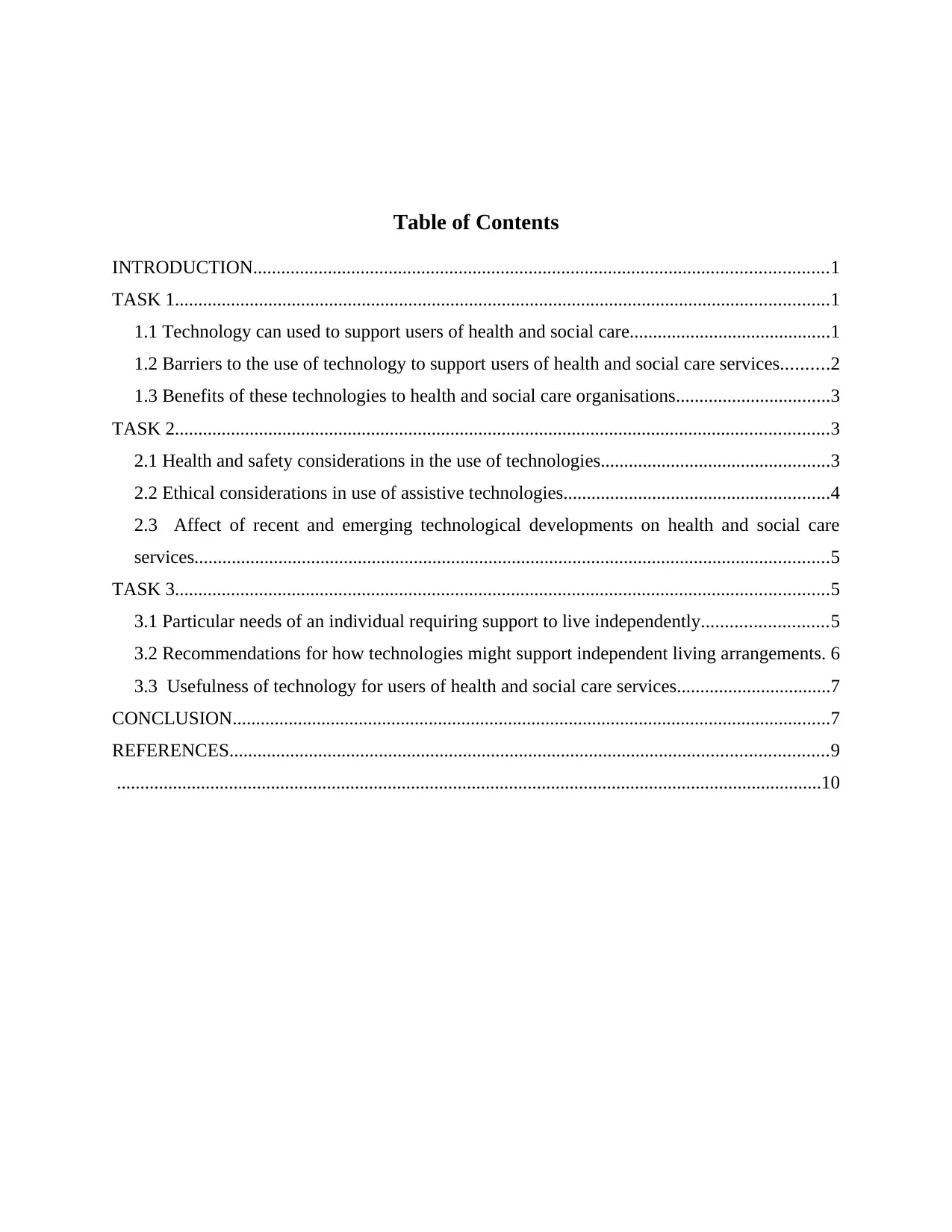
Table of Contents
INTRODUCTION...........................................................................................................................1
TASK 1............................................................................................................................................1
1.1 Technology can used to support users of health and social care...........................................1
1.2 Barriers to the use of technology to support users of health and social care services..........2
1.3 Benefits of these technologies to health and social care organisations.................................3
TASK 2............................................................................................................................................3
2.1 Health and safety considerations in the use of technologies.................................................3
2.2 Ethical considerations in use of assistive technologies.........................................................4
2.3 Affect of recent and emerging technological developments on health and social care
services........................................................................................................................................5
TASK 3............................................................................................................................................5
3.1 Particular needs of an individual requiring support to live independently...........................5
3.2 Recommendations for how technologies might support independent living arrangements. 6
3.3 Usefulness of technology for users of health and social care services.................................7
CONCLUSION................................................................................................................................7
REFERENCES................................................................................................................................9
.......................................................................................................................................................10
INTRODUCTION...........................................................................................................................1
TASK 1............................................................................................................................................1
1.1 Technology can used to support users of health and social care...........................................1
1.2 Barriers to the use of technology to support users of health and social care services..........2
1.3 Benefits of these technologies to health and social care organisations.................................3
TASK 2............................................................................................................................................3
2.1 Health and safety considerations in the use of technologies.................................................3
2.2 Ethical considerations in use of assistive technologies.........................................................4
2.3 Affect of recent and emerging technological developments on health and social care
services........................................................................................................................................5
TASK 3............................................................................................................................................5
3.1 Particular needs of an individual requiring support to live independently...........................5
3.2 Recommendations for how technologies might support independent living arrangements. 6
3.3 Usefulness of technology for users of health and social care services.................................7
CONCLUSION................................................................................................................................7
REFERENCES................................................................................................................................9
.......................................................................................................................................................10
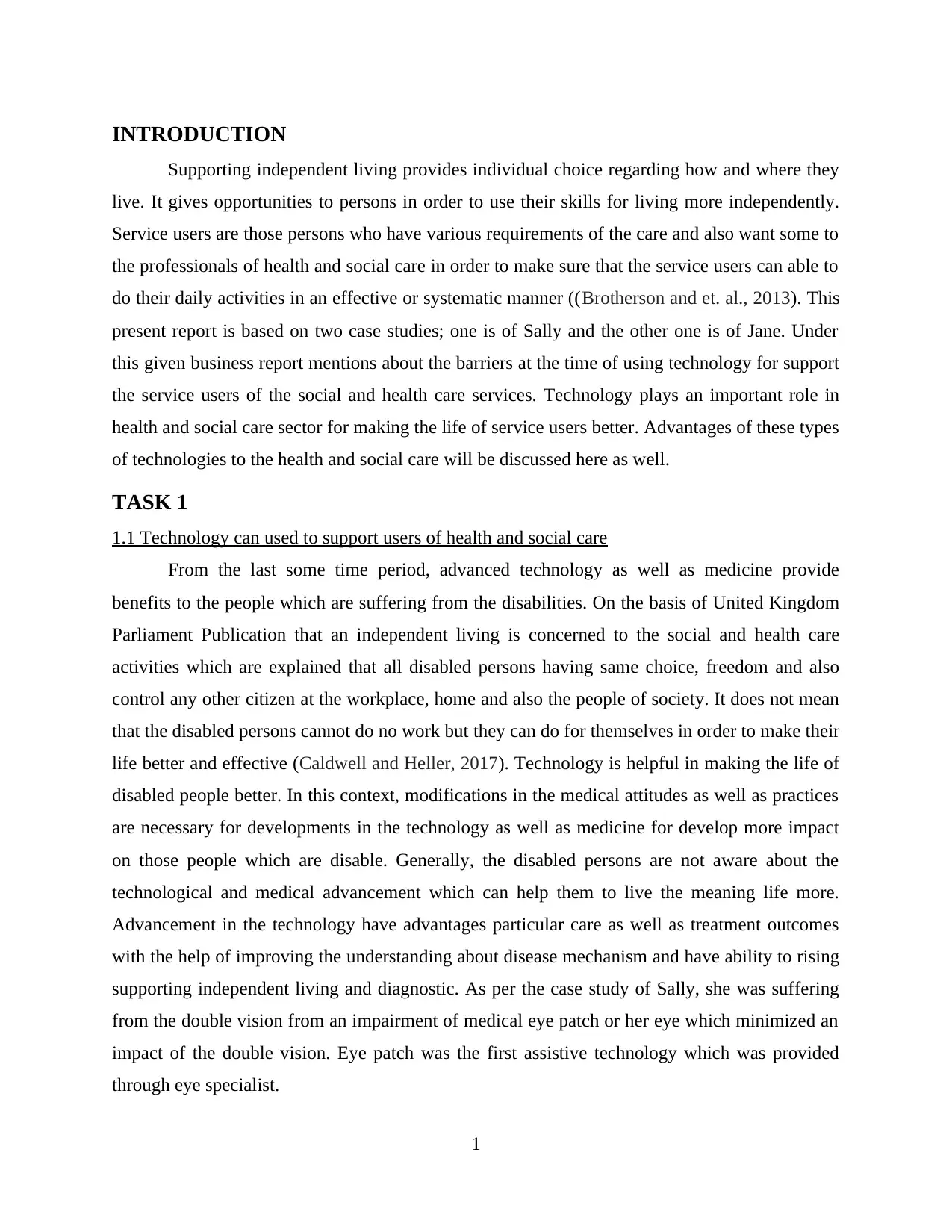
INTRODUCTION
Supporting independent living provides individual choice regarding how and where they
live. It gives opportunities to persons in order to use their skills for living more independently.
Service users are those persons who have various requirements of the care and also want some to
the professionals of health and social care in order to make sure that the service users can able to
do their daily activities in an effective or systematic manner ((Brotherson and et. al., 2013). This
present report is based on two case studies; one is of Sally and the other one is of Jane. Under
this given business report mentions about the barriers at the time of using technology for support
the service users of the social and health care services. Technology plays an important role in
health and social care sector for making the life of service users better. Advantages of these types
of technologies to the health and social care will be discussed here as well.
TASK 1
1.1 Technology can used to support users of health and social care
From the last some time period, advanced technology as well as medicine provide
benefits to the people which are suffering from the disabilities. On the basis of United Kingdom
Parliament Publication that an independent living is concerned to the social and health care
activities which are explained that all disabled persons having same choice, freedom and also
control any other citizen at the workplace, home and also the people of society. It does not mean
that the disabled persons cannot do no work but they can do for themselves in order to make their
life better and effective (Caldwell and Heller, 2017). Technology is helpful in making the life of
disabled people better. In this context, modifications in the medical attitudes as well as practices
are necessary for developments in the technology as well as medicine for develop more impact
on those people which are disable. Generally, the disabled persons are not aware about the
technological and medical advancement which can help them to live the meaning life more.
Advancement in the technology have advantages particular care as well as treatment outcomes
with the help of improving the understanding about disease mechanism and have ability to rising
supporting independent living and diagnostic. As per the case study of Sally, she was suffering
from the double vision from an impairment of medical eye patch or her eye which minimized an
impact of the double vision. Eye patch was the first assistive technology which was provided
through eye specialist.
1
Supporting independent living provides individual choice regarding how and where they
live. It gives opportunities to persons in order to use their skills for living more independently.
Service users are those persons who have various requirements of the care and also want some to
the professionals of health and social care in order to make sure that the service users can able to
do their daily activities in an effective or systematic manner ((Brotherson and et. al., 2013). This
present report is based on two case studies; one is of Sally and the other one is of Jane. Under
this given business report mentions about the barriers at the time of using technology for support
the service users of the social and health care services. Technology plays an important role in
health and social care sector for making the life of service users better. Advantages of these types
of technologies to the health and social care will be discussed here as well.
TASK 1
1.1 Technology can used to support users of health and social care
From the last some time period, advanced technology as well as medicine provide
benefits to the people which are suffering from the disabilities. On the basis of United Kingdom
Parliament Publication that an independent living is concerned to the social and health care
activities which are explained that all disabled persons having same choice, freedom and also
control any other citizen at the workplace, home and also the people of society. It does not mean
that the disabled persons cannot do no work but they can do for themselves in order to make their
life better and effective (Caldwell and Heller, 2017). Technology is helpful in making the life of
disabled people better. In this context, modifications in the medical attitudes as well as practices
are necessary for developments in the technology as well as medicine for develop more impact
on those people which are disable. Generally, the disabled persons are not aware about the
technological and medical advancement which can help them to live the meaning life more.
Advancement in the technology have advantages particular care as well as treatment outcomes
with the help of improving the understanding about disease mechanism and have ability to rising
supporting independent living and diagnostic. As per the case study of Sally, she was suffering
from the double vision from an impairment of medical eye patch or her eye which minimized an
impact of the double vision. Eye patch was the first assistive technology which was provided
through eye specialist.
1
⊘ This is a preview!⊘
Do you want full access?
Subscribe today to unlock all pages.

Trusted by 1+ million students worldwide
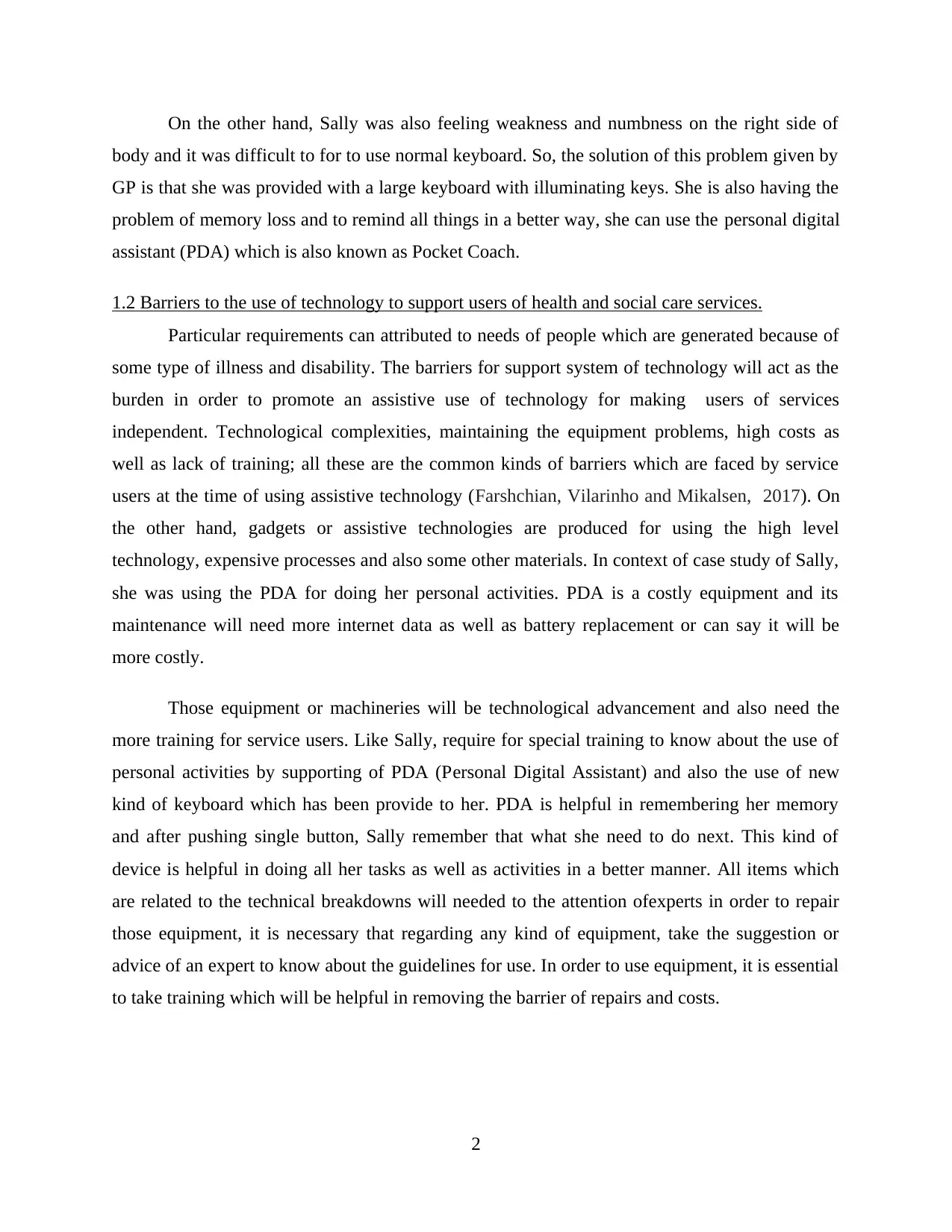
On the other hand, Sally was also feeling weakness and numbness on the right side of
body and it was difficult to for to use normal keyboard. So, the solution of this problem given by
GP is that she was provided with a large keyboard with illuminating keys. She is also having the
problem of memory loss and to remind all things in a better way, she can use the personal digital
assistant (PDA) which is also known as Pocket Coach.
1.2 Barriers to the use of technology to support users of health and social care services.
Particular requirements can attributed to needs of people which are generated because of
some type of illness and disability. The barriers for support system of technology will act as the
burden in order to promote an assistive use of technology for making users of services
independent. Technological complexities, maintaining the equipment problems, high costs as
well as lack of training; all these are the common kinds of barriers which are faced by service
users at the time of using assistive technology (Farshchian, Vilarinho and Mikalsen, 2017). On
the other hand, gadgets or assistive technologies are produced for using the high level
technology, expensive processes and also some other materials. In context of case study of Sally,
she was using the PDA for doing her personal activities. PDA is a costly equipment and its
maintenance will need more internet data as well as battery replacement or can say it will be
more costly.
Those equipment or machineries will be technological advancement and also need the
more training for service users. Like Sally, require for special training to know about the use of
personal activities by supporting of PDA (Personal Digital Assistant) and also the use of new
kind of keyboard which has been provide to her. PDA is helpful in remembering her memory
and after pushing single button, Sally remember that what she need to do next. This kind of
device is helpful in doing all her tasks as well as activities in a better manner. All items which
are related to the technical breakdowns will needed to the attention ofexperts in order to repair
those equipment, it is necessary that regarding any kind of equipment, take the suggestion or
advice of an expert to know about the guidelines for use. In order to use equipment, it is essential
to take training which will be helpful in removing the barrier of repairs and costs.
2
body and it was difficult to for to use normal keyboard. So, the solution of this problem given by
GP is that she was provided with a large keyboard with illuminating keys. She is also having the
problem of memory loss and to remind all things in a better way, she can use the personal digital
assistant (PDA) which is also known as Pocket Coach.
1.2 Barriers to the use of technology to support users of health and social care services.
Particular requirements can attributed to needs of people which are generated because of
some type of illness and disability. The barriers for support system of technology will act as the
burden in order to promote an assistive use of technology for making users of services
independent. Technological complexities, maintaining the equipment problems, high costs as
well as lack of training; all these are the common kinds of barriers which are faced by service
users at the time of using assistive technology (Farshchian, Vilarinho and Mikalsen, 2017). On
the other hand, gadgets or assistive technologies are produced for using the high level
technology, expensive processes and also some other materials. In context of case study of Sally,
she was using the PDA for doing her personal activities. PDA is a costly equipment and its
maintenance will need more internet data as well as battery replacement or can say it will be
more costly.
Those equipment or machineries will be technological advancement and also need the
more training for service users. Like Sally, require for special training to know about the use of
personal activities by supporting of PDA (Personal Digital Assistant) and also the use of new
kind of keyboard which has been provide to her. PDA is helpful in remembering her memory
and after pushing single button, Sally remember that what she need to do next. This kind of
device is helpful in doing all her tasks as well as activities in a better manner. All items which
are related to the technical breakdowns will needed to the attention ofexperts in order to repair
those equipment, it is necessary that regarding any kind of equipment, take the suggestion or
advice of an expert to know about the guidelines for use. In order to use equipment, it is essential
to take training which will be helpful in removing the barrier of repairs and costs.
2
Paraphrase This Document
Need a fresh take? Get an instant paraphrase of this document with our AI Paraphraser
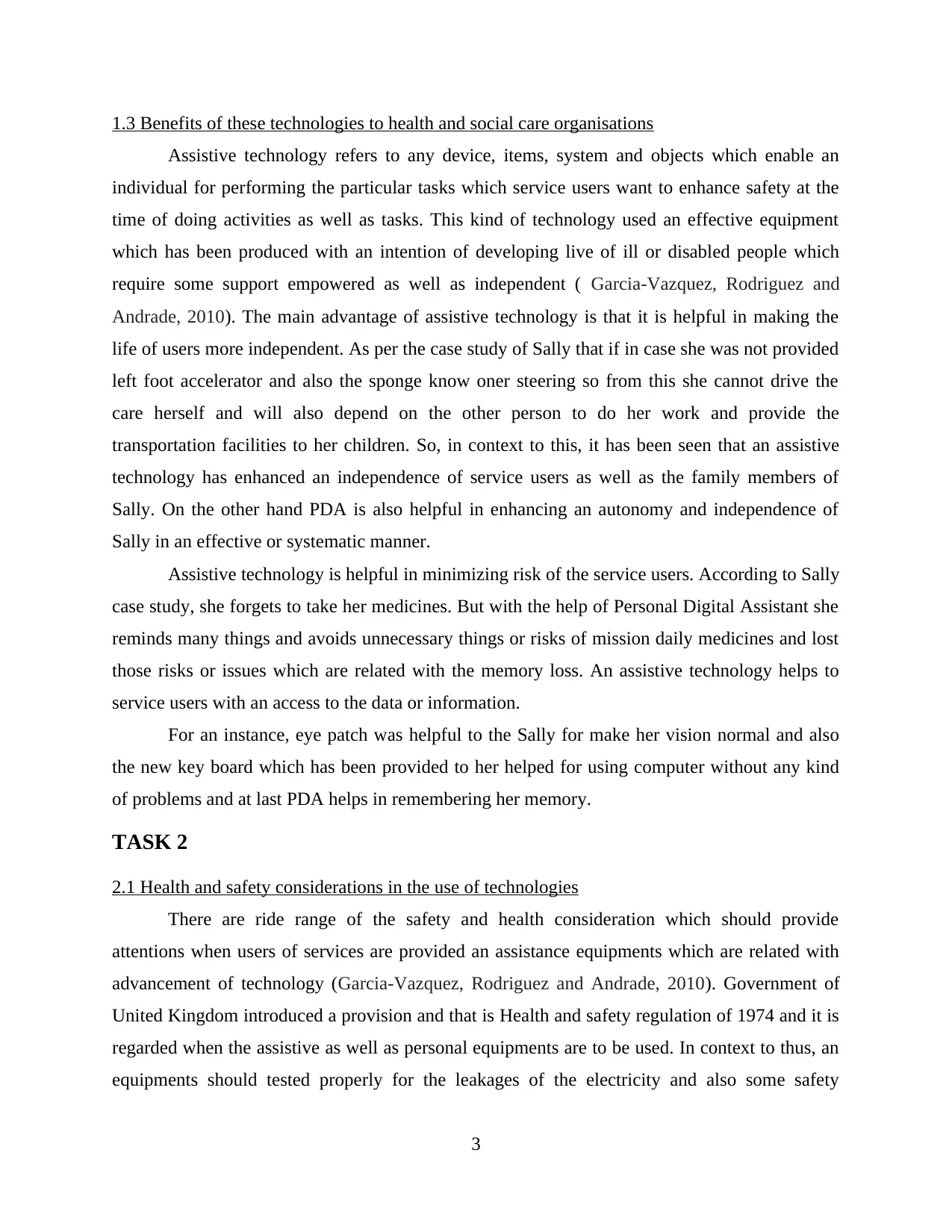
1.3 Benefits of these technologies to health and social care organisations
Assistive technology refers to any device, items, system and objects which enable an
individual for performing the particular tasks which service users want to enhance safety at the
time of doing activities as well as tasks. This kind of technology used an effective equipment
which has been produced with an intention of developing live of ill or disabled people which
require some support empowered as well as independent ( Garcia-Vazquez, Rodriguez and
Andrade, 2010). The main advantage of assistive technology is that it is helpful in making the
life of users more independent. As per the case study of Sally that if in case she was not provided
left foot accelerator and also the sponge know oner steering so from this she cannot drive the
care herself and will also depend on the other person to do her work and provide the
transportation facilities to her children. So, in context to this, it has been seen that an assistive
technology has enhanced an independence of service users as well as the family members of
Sally. On the other hand PDA is also helpful in enhancing an autonomy and independence of
Sally in an effective or systematic manner.
Assistive technology is helpful in minimizing risk of the service users. According to Sally
case study, she forgets to take her medicines. But with the help of Personal Digital Assistant she
reminds many things and avoids unnecessary things or risks of mission daily medicines and lost
those risks or issues which are related with the memory loss. An assistive technology helps to
service users with an access to the data or information.
For an instance, eye patch was helpful to the Sally for make her vision normal and also
the new key board which has been provided to her helped for using computer without any kind
of problems and at last PDA helps in remembering her memory.
TASK 2
2.1 Health and safety considerations in the use of technologies
There are ride range of the safety and health consideration which should provide
attentions when users of services are provided an assistance equipments which are related with
advancement of technology (Garcia-Vazquez, Rodriguez and Andrade, 2010). Government of
United Kingdom introduced a provision and that is Health and safety regulation of 1974 and it is
regarded when the assistive as well as personal equipments are to be used. In context to thus, an
equipments should tested properly for the leakages of the electricity and also some safety
3
Assistive technology refers to any device, items, system and objects which enable an
individual for performing the particular tasks which service users want to enhance safety at the
time of doing activities as well as tasks. This kind of technology used an effective equipment
which has been produced with an intention of developing live of ill or disabled people which
require some support empowered as well as independent ( Garcia-Vazquez, Rodriguez and
Andrade, 2010). The main advantage of assistive technology is that it is helpful in making the
life of users more independent. As per the case study of Sally that if in case she was not provided
left foot accelerator and also the sponge know oner steering so from this she cannot drive the
care herself and will also depend on the other person to do her work and provide the
transportation facilities to her children. So, in context to this, it has been seen that an assistive
technology has enhanced an independence of service users as well as the family members of
Sally. On the other hand PDA is also helpful in enhancing an autonomy and independence of
Sally in an effective or systematic manner.
Assistive technology is helpful in minimizing risk of the service users. According to Sally
case study, she forgets to take her medicines. But with the help of Personal Digital Assistant she
reminds many things and avoids unnecessary things or risks of mission daily medicines and lost
those risks or issues which are related with the memory loss. An assistive technology helps to
service users with an access to the data or information.
For an instance, eye patch was helpful to the Sally for make her vision normal and also
the new key board which has been provided to her helped for using computer without any kind
of problems and at last PDA helps in remembering her memory.
TASK 2
2.1 Health and safety considerations in the use of technologies
There are ride range of the safety and health consideration which should provide
attentions when users of services are provided an assistance equipments which are related with
advancement of technology (Garcia-Vazquez, Rodriguez and Andrade, 2010). Government of
United Kingdom introduced a provision and that is Health and safety regulation of 1974 and it is
regarded when the assistive as well as personal equipments are to be used. In context to thus, an
equipments should tested properly for the leakages of the electricity and also some safety
3
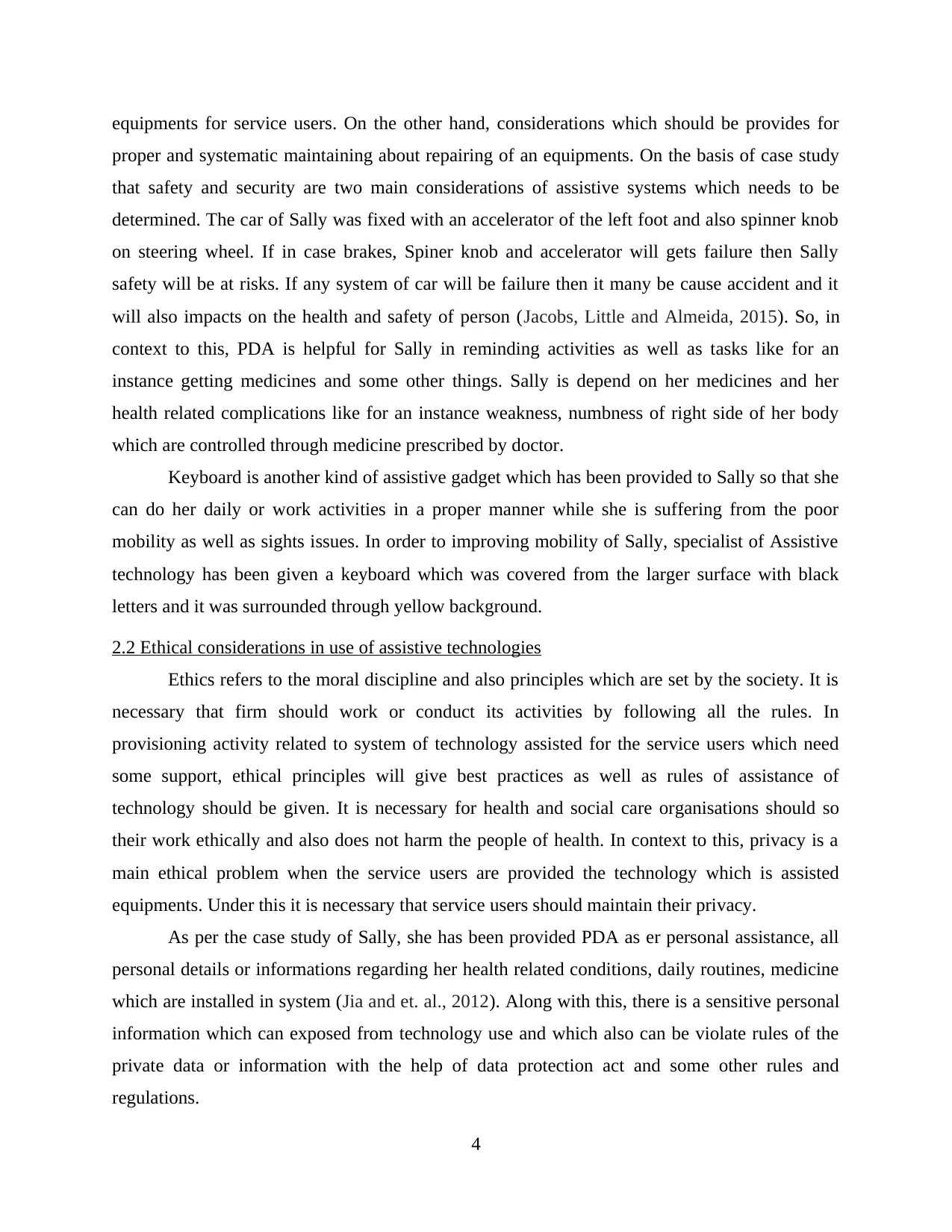
equipments for service users. On the other hand, considerations which should be provides for
proper and systematic maintaining about repairing of an equipments. On the basis of case study
that safety and security are two main considerations of assistive systems which needs to be
determined. The car of Sally was fixed with an accelerator of the left foot and also spinner knob
on steering wheel. If in case brakes, Spiner knob and accelerator will gets failure then Sally
safety will be at risks. If any system of car will be failure then it many be cause accident and it
will also impacts on the health and safety of person (Jacobs, Little and Almeida, 2015). So, in
context to this, PDA is helpful for Sally in reminding activities as well as tasks like for an
instance getting medicines and some other things. Sally is depend on her medicines and her
health related complications like for an instance weakness, numbness of right side of her body
which are controlled through medicine prescribed by doctor.
Keyboard is another kind of assistive gadget which has been provided to Sally so that she
can do her daily or work activities in a proper manner while she is suffering from the poor
mobility as well as sights issues. In order to improving mobility of Sally, specialist of Assistive
technology has been given a keyboard which was covered from the larger surface with black
letters and it was surrounded through yellow background.
2.2 Ethical considerations in use of assistive technologies
Ethics refers to the moral discipline and also principles which are set by the society. It is
necessary that firm should work or conduct its activities by following all the rules. In
provisioning activity related to system of technology assisted for the service users which need
some support, ethical principles will give best practices as well as rules of assistance of
technology should be given. It is necessary for health and social care organisations should so
their work ethically and also does not harm the people of health. In context to this, privacy is a
main ethical problem when the service users are provided the technology which is assisted
equipments. Under this it is necessary that service users should maintain their privacy.
As per the case study of Sally, she has been provided PDA as er personal assistance, all
personal details or informations regarding her health related conditions, daily routines, medicine
which are installed in system (Jia and et. al., 2012). Along with this, there is a sensitive personal
information which can exposed from technology use and which also can be violate rules of the
private data or information with the help of data protection act and some other rules and
regulations.
4
proper and systematic maintaining about repairing of an equipments. On the basis of case study
that safety and security are two main considerations of assistive systems which needs to be
determined. The car of Sally was fixed with an accelerator of the left foot and also spinner knob
on steering wheel. If in case brakes, Spiner knob and accelerator will gets failure then Sally
safety will be at risks. If any system of car will be failure then it many be cause accident and it
will also impacts on the health and safety of person (Jacobs, Little and Almeida, 2015). So, in
context to this, PDA is helpful for Sally in reminding activities as well as tasks like for an
instance getting medicines and some other things. Sally is depend on her medicines and her
health related complications like for an instance weakness, numbness of right side of her body
which are controlled through medicine prescribed by doctor.
Keyboard is another kind of assistive gadget which has been provided to Sally so that she
can do her daily or work activities in a proper manner while she is suffering from the poor
mobility as well as sights issues. In order to improving mobility of Sally, specialist of Assistive
technology has been given a keyboard which was covered from the larger surface with black
letters and it was surrounded through yellow background.
2.2 Ethical considerations in use of assistive technologies
Ethics refers to the moral discipline and also principles which are set by the society. It is
necessary that firm should work or conduct its activities by following all the rules. In
provisioning activity related to system of technology assisted for the service users which need
some support, ethical principles will give best practices as well as rules of assistance of
technology should be given. It is necessary for health and social care organisations should so
their work ethically and also does not harm the people of health. In context to this, privacy is a
main ethical problem when the service users are provided the technology which is assisted
equipments. Under this it is necessary that service users should maintain their privacy.
As per the case study of Sally, she has been provided PDA as er personal assistance, all
personal details or informations regarding her health related conditions, daily routines, medicine
which are installed in system (Jia and et. al., 2012). Along with this, there is a sensitive personal
information which can exposed from technology use and which also can be violate rules of the
private data or information with the help of data protection act and some other rules and
regulations.
4
⊘ This is a preview!⊘
Do you want full access?
Subscribe today to unlock all pages.

Trusted by 1+ million students worldwide
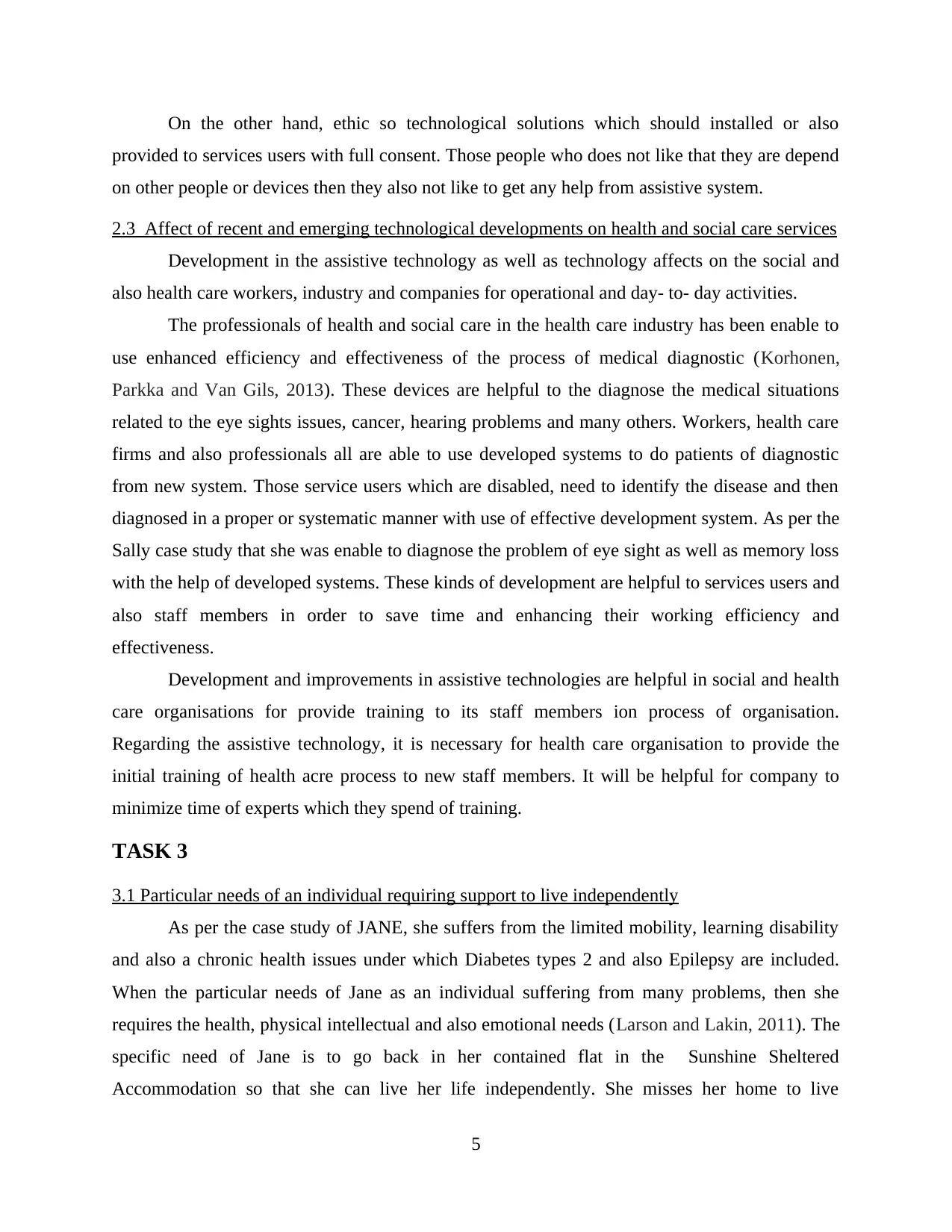
On the other hand, ethic so technological solutions which should installed or also
provided to services users with full consent. Those people who does not like that they are depend
on other people or devices then they also not like to get any help from assistive system.
2.3 Affect of recent and emerging technological developments on health and social care services
Development in the assistive technology as well as technology affects on the social and
also health care workers, industry and companies for operational and day- to- day activities.
The professionals of health and social care in the health care industry has been enable to
use enhanced efficiency and effectiveness of the process of medical diagnostic (Korhonen,
Parkka and Van Gils, 2013). These devices are helpful to the diagnose the medical situations
related to the eye sights issues, cancer, hearing problems and many others. Workers, health care
firms and also professionals all are able to use developed systems to do patients of diagnostic
from new system. Those service users which are disabled, need to identify the disease and then
diagnosed in a proper or systematic manner with use of effective development system. As per the
Sally case study that she was enable to diagnose the problem of eye sight as well as memory loss
with the help of developed systems. These kinds of development are helpful to services users and
also staff members in order to save time and enhancing their working efficiency and
effectiveness.
Development and improvements in assistive technologies are helpful in social and health
care organisations for provide training to its staff members ion process of organisation.
Regarding the assistive technology, it is necessary for health care organisation to provide the
initial training of health acre process to new staff members. It will be helpful for company to
minimize time of experts which they spend of training.
TASK 3
3.1 Particular needs of an individual requiring support to live independently
As per the case study of JANE, she suffers from the limited mobility, learning disability
and also a chronic health issues under which Diabetes types 2 and also Epilepsy are included.
When the particular needs of Jane as an individual suffering from many problems, then she
requires the health, physical intellectual and also emotional needs (Larson and Lakin, 2011). The
specific need of Jane is to go back in her contained flat in the Sunshine Sheltered
Accommodation so that she can live her life independently. She misses her home to live
5
provided to services users with full consent. Those people who does not like that they are depend
on other people or devices then they also not like to get any help from assistive system.
2.3 Affect of recent and emerging technological developments on health and social care services
Development in the assistive technology as well as technology affects on the social and
also health care workers, industry and companies for operational and day- to- day activities.
The professionals of health and social care in the health care industry has been enable to
use enhanced efficiency and effectiveness of the process of medical diagnostic (Korhonen,
Parkka and Van Gils, 2013). These devices are helpful to the diagnose the medical situations
related to the eye sights issues, cancer, hearing problems and many others. Workers, health care
firms and also professionals all are able to use developed systems to do patients of diagnostic
from new system. Those service users which are disabled, need to identify the disease and then
diagnosed in a proper or systematic manner with use of effective development system. As per the
Sally case study that she was enable to diagnose the problem of eye sight as well as memory loss
with the help of developed systems. These kinds of development are helpful to services users and
also staff members in order to save time and enhancing their working efficiency and
effectiveness.
Development and improvements in assistive technologies are helpful in social and health
care organisations for provide training to its staff members ion process of organisation.
Regarding the assistive technology, it is necessary for health care organisation to provide the
initial training of health acre process to new staff members. It will be helpful for company to
minimize time of experts which they spend of training.
TASK 3
3.1 Particular needs of an individual requiring support to live independently
As per the case study of JANE, she suffers from the limited mobility, learning disability
and also a chronic health issues under which Diabetes types 2 and also Epilepsy are included.
When the particular needs of Jane as an individual suffering from many problems, then she
requires the health, physical intellectual and also emotional needs (Larson and Lakin, 2011). The
specific need of Jane is to go back in her contained flat in the Sunshine Sheltered
Accommodation so that she can live her life independently. She misses her home to live
5
Paraphrase This Document
Need a fresh take? Get an instant paraphrase of this document with our AI Paraphraser
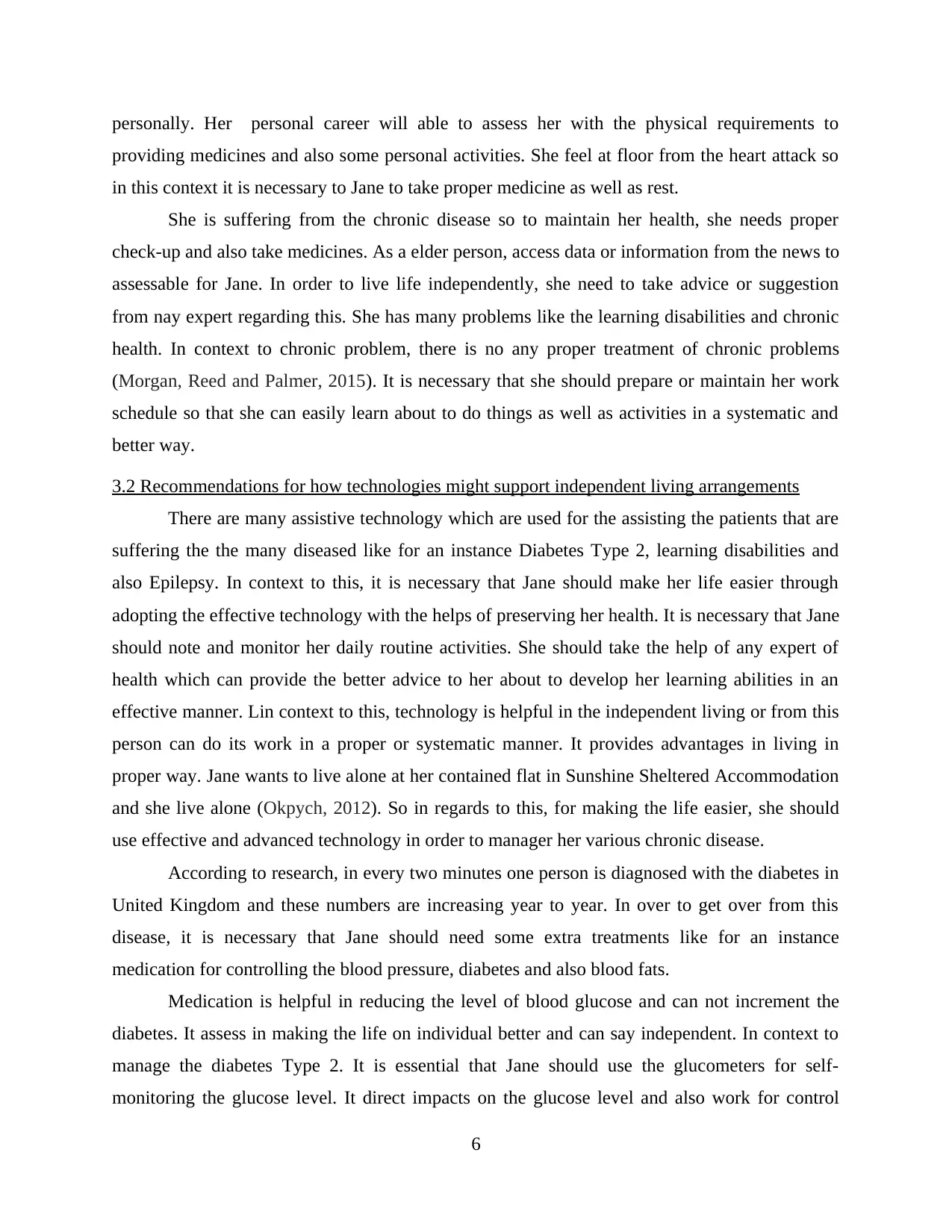
personally. Her personal career will able to assess her with the physical requirements to
providing medicines and also some personal activities. She feel at floor from the heart attack so
in this context it is necessary to Jane to take proper medicine as well as rest.
She is suffering from the chronic disease so to maintain her health, she needs proper
check-up and also take medicines. As a elder person, access data or information from the news to
assessable for Jane. In order to live life independently, she need to take advice or suggestion
from nay expert regarding this. She has many problems like the learning disabilities and chronic
health. In context to chronic problem, there is no any proper treatment of chronic problems
(Morgan, Reed and Palmer, 2015). It is necessary that she should prepare or maintain her work
schedule so that she can easily learn about to do things as well as activities in a systematic and
better way.
3.2 Recommendations for how technologies might support independent living arrangements
There are many assistive technology which are used for the assisting the patients that are
suffering the the many diseased like for an instance Diabetes Type 2, learning disabilities and
also Epilepsy. In context to this, it is necessary that Jane should make her life easier through
adopting the effective technology with the helps of preserving her health. It is necessary that Jane
should note and monitor her daily routine activities. She should take the help of any expert of
health which can provide the better advice to her about to develop her learning abilities in an
effective manner. Lin context to this, technology is helpful in the independent living or from this
person can do its work in a proper or systematic manner. It provides advantages in living in
proper way. Jane wants to live alone at her contained flat in Sunshine Sheltered Accommodation
and she live alone (Okpych, 2012). So in regards to this, for making the life easier, she should
use effective and advanced technology in order to manager her various chronic disease.
According to research, in every two minutes one person is diagnosed with the diabetes in
United Kingdom and these numbers are increasing year to year. In over to get over from this
disease, it is necessary that Jane should need some extra treatments like for an instance
medication for controlling the blood pressure, diabetes and also blood fats.
Medication is helpful in reducing the level of blood glucose and can not increment the
diabetes. It assess in making the life on individual better and can say independent. In context to
manage the diabetes Type 2. It is essential that Jane should use the glucometers for self-
monitoring the glucose level. It direct impacts on the glucose level and also work for control
6
providing medicines and also some personal activities. She feel at floor from the heart attack so
in this context it is necessary to Jane to take proper medicine as well as rest.
She is suffering from the chronic disease so to maintain her health, she needs proper
check-up and also take medicines. As a elder person, access data or information from the news to
assessable for Jane. In order to live life independently, she need to take advice or suggestion
from nay expert regarding this. She has many problems like the learning disabilities and chronic
health. In context to chronic problem, there is no any proper treatment of chronic problems
(Morgan, Reed and Palmer, 2015). It is necessary that she should prepare or maintain her work
schedule so that she can easily learn about to do things as well as activities in a systematic and
better way.
3.2 Recommendations for how technologies might support independent living arrangements
There are many assistive technology which are used for the assisting the patients that are
suffering the the many diseased like for an instance Diabetes Type 2, learning disabilities and
also Epilepsy. In context to this, it is necessary that Jane should make her life easier through
adopting the effective technology with the helps of preserving her health. It is necessary that Jane
should note and monitor her daily routine activities. She should take the help of any expert of
health which can provide the better advice to her about to develop her learning abilities in an
effective manner. Lin context to this, technology is helpful in the independent living or from this
person can do its work in a proper or systematic manner. It provides advantages in living in
proper way. Jane wants to live alone at her contained flat in Sunshine Sheltered Accommodation
and she live alone (Okpych, 2012). So in regards to this, for making the life easier, she should
use effective and advanced technology in order to manager her various chronic disease.
According to research, in every two minutes one person is diagnosed with the diabetes in
United Kingdom and these numbers are increasing year to year. In over to get over from this
disease, it is necessary that Jane should need some extra treatments like for an instance
medication for controlling the blood pressure, diabetes and also blood fats.
Medication is helpful in reducing the level of blood glucose and can not increment the
diabetes. It assess in making the life on individual better and can say independent. In context to
manage the diabetes Type 2. It is essential that Jane should use the glucometers for self-
monitoring the glucose level. It direct impacts on the glucose level and also work for control
6
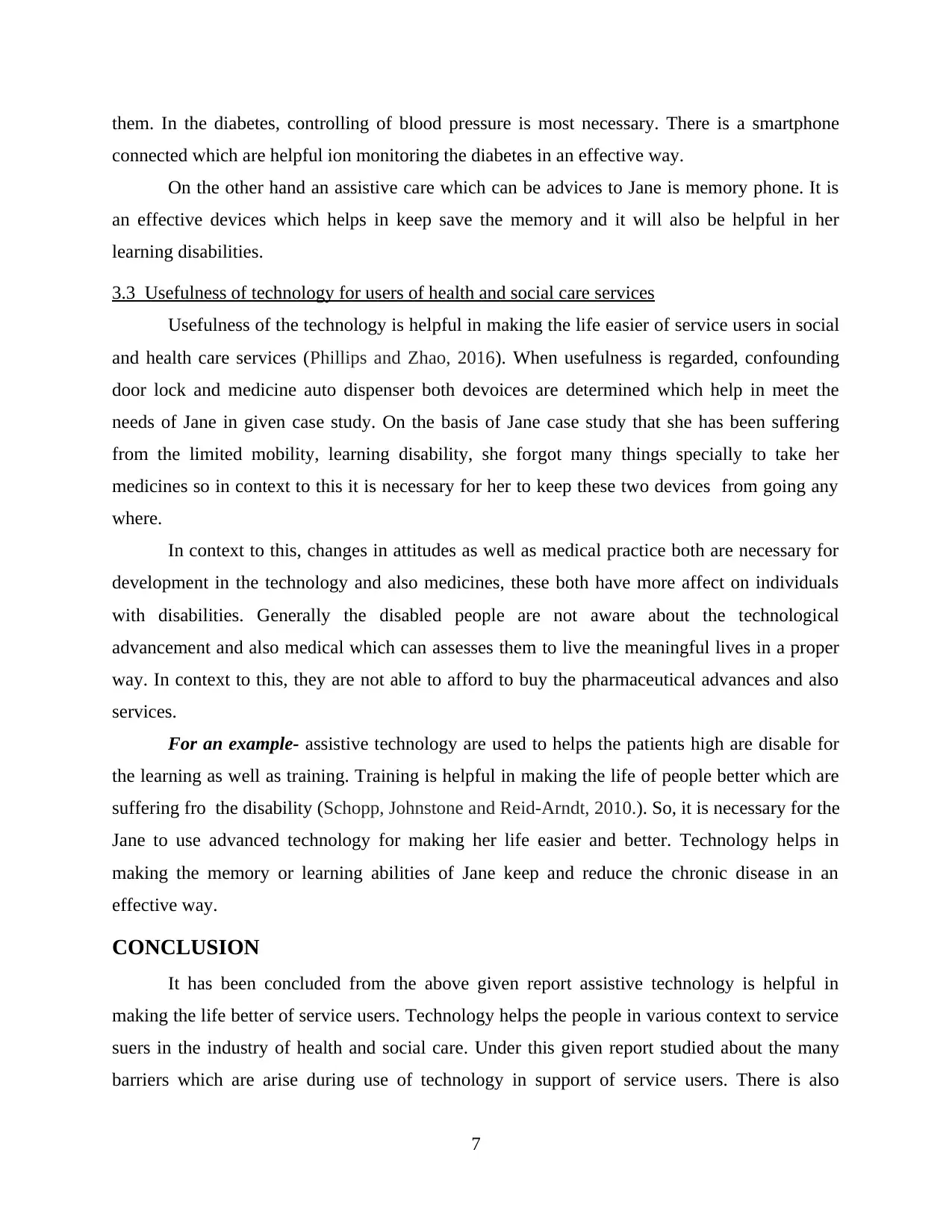
them. In the diabetes, controlling of blood pressure is most necessary. There is a smartphone
connected which are helpful ion monitoring the diabetes in an effective way.
On the other hand an assistive care which can be advices to Jane is memory phone. It is
an effective devices which helps in keep save the memory and it will also be helpful in her
learning disabilities.
3.3 Usefulness of technology for users of health and social care services
Usefulness of the technology is helpful in making the life easier of service users in social
and health care services (Phillips and Zhao, 2016). When usefulness is regarded, confounding
door lock and medicine auto dispenser both devoices are determined which help in meet the
needs of Jane in given case study. On the basis of Jane case study that she has been suffering
from the limited mobility, learning disability, she forgot many things specially to take her
medicines so in context to this it is necessary for her to keep these two devices from going any
where.
In context to this, changes in attitudes as well as medical practice both are necessary for
development in the technology and also medicines, these both have more affect on individuals
with disabilities. Generally the disabled people are not aware about the technological
advancement and also medical which can assesses them to live the meaningful lives in a proper
way. In context to this, they are not able to afford to buy the pharmaceutical advances and also
services.
For an example- assistive technology are used to helps the patients high are disable for
the learning as well as training. Training is helpful in making the life of people better which are
suffering fro the disability (Schopp, Johnstone and Reid-Arndt, 2010.). So, it is necessary for the
Jane to use advanced technology for making her life easier and better. Technology helps in
making the memory or learning abilities of Jane keep and reduce the chronic disease in an
effective way.
CONCLUSION
It has been concluded from the above given report assistive technology is helpful in
making the life better of service users. Technology helps the people in various context to service
suers in the industry of health and social care. Under this given report studied about the many
barriers which are arise during use of technology in support of service users. There is also
7
connected which are helpful ion monitoring the diabetes in an effective way.
On the other hand an assistive care which can be advices to Jane is memory phone. It is
an effective devices which helps in keep save the memory and it will also be helpful in her
learning disabilities.
3.3 Usefulness of technology for users of health and social care services
Usefulness of the technology is helpful in making the life easier of service users in social
and health care services (Phillips and Zhao, 2016). When usefulness is regarded, confounding
door lock and medicine auto dispenser both devoices are determined which help in meet the
needs of Jane in given case study. On the basis of Jane case study that she has been suffering
from the limited mobility, learning disability, she forgot many things specially to take her
medicines so in context to this it is necessary for her to keep these two devices from going any
where.
In context to this, changes in attitudes as well as medical practice both are necessary for
development in the technology and also medicines, these both have more affect on individuals
with disabilities. Generally the disabled people are not aware about the technological
advancement and also medical which can assesses them to live the meaningful lives in a proper
way. In context to this, they are not able to afford to buy the pharmaceutical advances and also
services.
For an example- assistive technology are used to helps the patients high are disable for
the learning as well as training. Training is helpful in making the life of people better which are
suffering fro the disability (Schopp, Johnstone and Reid-Arndt, 2010.). So, it is necessary for the
Jane to use advanced technology for making her life easier and better. Technology helps in
making the memory or learning abilities of Jane keep and reduce the chronic disease in an
effective way.
CONCLUSION
It has been concluded from the above given report assistive technology is helpful in
making the life better of service users. Technology helps the people in various context to service
suers in the industry of health and social care. Under this given report studied about the many
barriers which are arise during use of technology in support of service users. There is also
7
⊘ This is a preview!⊘
Do you want full access?
Subscribe today to unlock all pages.

Trusted by 1+ million students worldwide
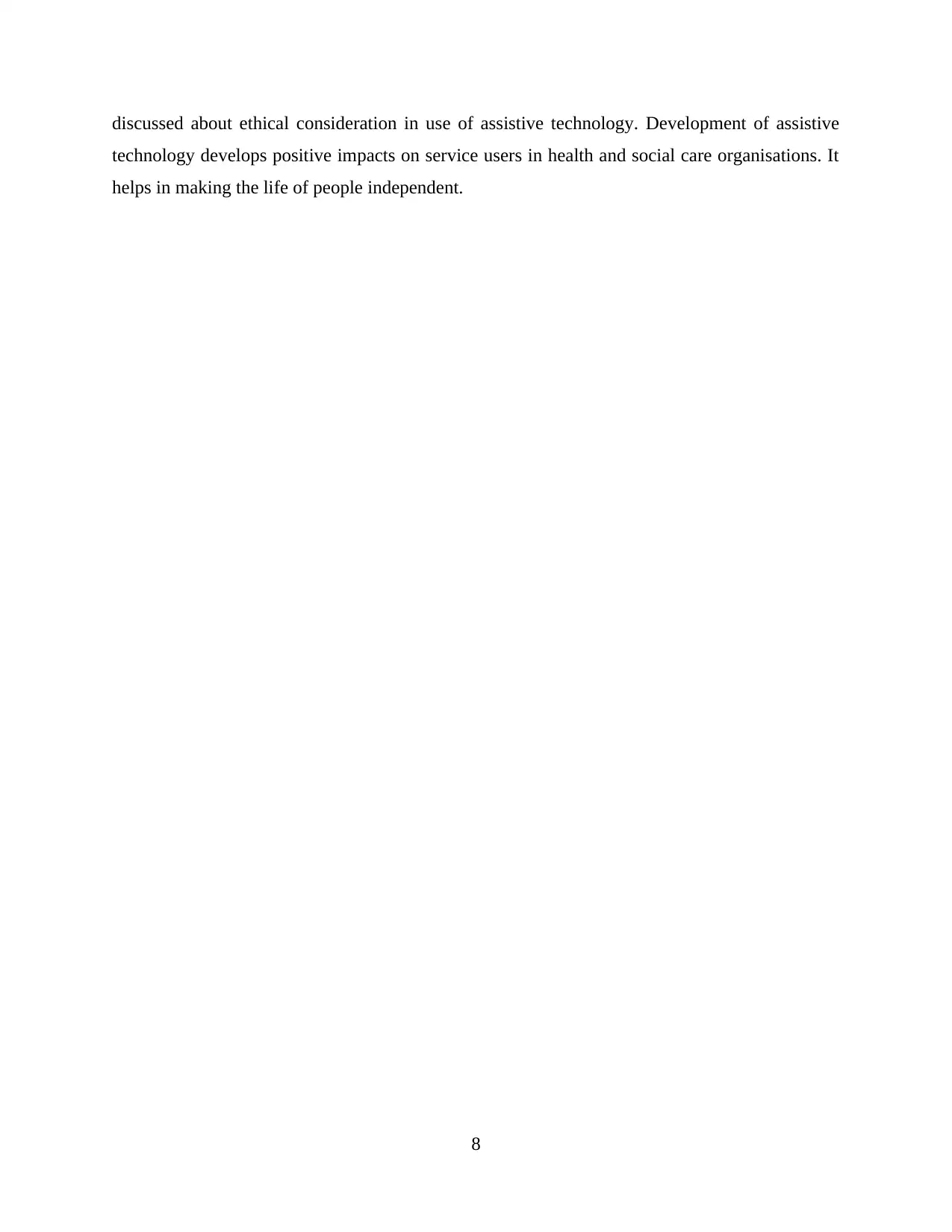
discussed about ethical consideration in use of assistive technology. Development of assistive
technology develops positive impacts on service users in health and social care organisations. It
helps in making the life of people independent.
8
technology develops positive impacts on service users in health and social care organisations. It
helps in making the life of people independent.
8
Paraphrase This Document
Need a fresh take? Get an instant paraphrase of this document with our AI Paraphraser
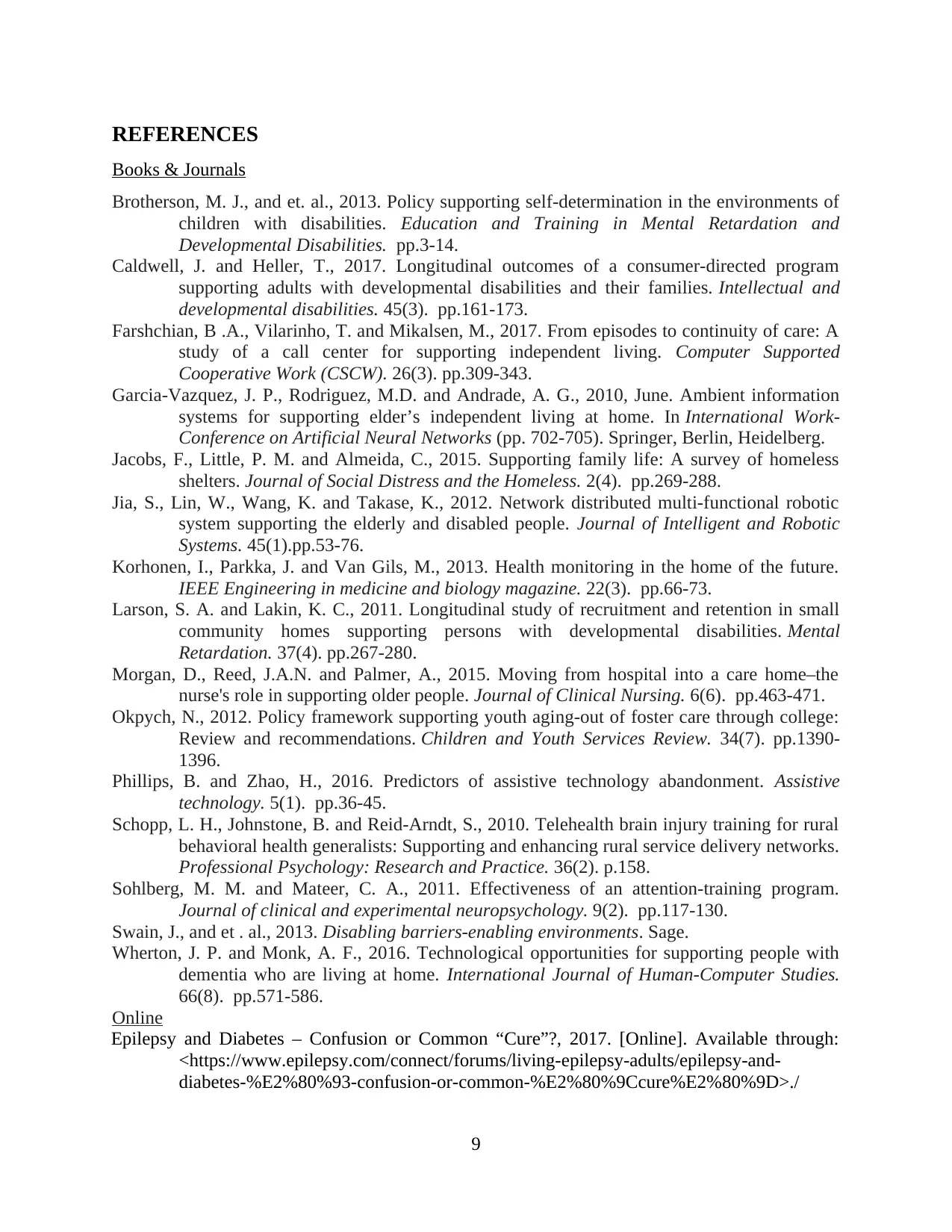
REFERENCES
Books & Journals
Brotherson, M. J., and et. al., 2013. Policy supporting self-determination in the environments of
children with disabilities. Education and Training in Mental Retardation and
Developmental Disabilities. pp.3-14.
Caldwell, J. and Heller, T., 2017. Longitudinal outcomes of a consumer-directed program
supporting adults with developmental disabilities and their families. Intellectual and
developmental disabilities. 45(3). pp.161-173.
Farshchian, B .A., Vilarinho, T. and Mikalsen, M., 2017. From episodes to continuity of care: A
study of a call center for supporting independent living. Computer Supported
Cooperative Work (CSCW). 26(3). pp.309-343.
Garcia-Vazquez, J. P., Rodriguez, M.D. and Andrade, A. G., 2010, June. Ambient information
systems for supporting elder’s independent living at home. In International Work-
Conference on Artificial Neural Networks (pp. 702-705). Springer, Berlin, Heidelberg.
Jacobs, F., Little, P. M. and Almeida, C., 2015. Supporting family life: A survey of homeless
shelters. Journal of Social Distress and the Homeless. 2(4). pp.269-288.
Jia, S., Lin, W., Wang, K. and Takase, K., 2012. Network distributed multi-functional robotic
system supporting the elderly and disabled people. Journal of Intelligent and Robotic
Systems. 45(1).pp.53-76.
Korhonen, I., Parkka, J. and Van Gils, M., 2013. Health monitoring in the home of the future.
IEEE Engineering in medicine and biology magazine. 22(3). pp.66-73.
Larson, S. A. and Lakin, K. C., 2011. Longitudinal study of recruitment and retention in small
community homes supporting persons with developmental disabilities. Mental
Retardation. 37(4). pp.267-280.
Morgan, D., Reed, J.A.N. and Palmer, A., 2015. Moving from hospital into a care home–the
nurse's role in supporting older people. Journal of Clinical Nursing. 6(6). pp.463-471.
Okpych, N., 2012. Policy framework supporting youth aging-out of foster care through college:
Review and recommendations. Children and Youth Services Review. 34(7). pp.1390-
1396.
Phillips, B. and Zhao, H., 2016. Predictors of assistive technology abandonment. Assistive
technology. 5(1). pp.36-45.
Schopp, L. H., Johnstone, B. and Reid-Arndt, S., 2010. Telehealth brain injury training for rural
behavioral health generalists: Supporting and enhancing rural service delivery networks.
Professional Psychology: Research and Practice. 36(2). p.158.
Sohlberg, M. M. and Mateer, C. A., 2011. Effectiveness of an attention-training program.
Journal of clinical and experimental neuropsychology. 9(2). pp.117-130.
Swain, J., and et . al., 2013. Disabling barriers-enabling environments. Sage.
Wherton, J. P. and Monk, A. F., 2016. Technological opportunities for supporting people with
dementia who are living at home. International Journal of Human-Computer Studies.
66(8). pp.571-586.
Online
Epilepsy and Diabetes – Confusion or Common “Cure”?, 2017. [Online]. Available through:
<https://www.epilepsy.com/connect/forums/living-epilepsy-adults/epilepsy-and-
diabetes-%E2%80%93-confusion-or-common-%E2%80%9Ccure%E2%80%9D>./
9
Books & Journals
Brotherson, M. J., and et. al., 2013. Policy supporting self-determination in the environments of
children with disabilities. Education and Training in Mental Retardation and
Developmental Disabilities. pp.3-14.
Caldwell, J. and Heller, T., 2017. Longitudinal outcomes of a consumer-directed program
supporting adults with developmental disabilities and their families. Intellectual and
developmental disabilities. 45(3). pp.161-173.
Farshchian, B .A., Vilarinho, T. and Mikalsen, M., 2017. From episodes to continuity of care: A
study of a call center for supporting independent living. Computer Supported
Cooperative Work (CSCW). 26(3). pp.309-343.
Garcia-Vazquez, J. P., Rodriguez, M.D. and Andrade, A. G., 2010, June. Ambient information
systems for supporting elder’s independent living at home. In International Work-
Conference on Artificial Neural Networks (pp. 702-705). Springer, Berlin, Heidelberg.
Jacobs, F., Little, P. M. and Almeida, C., 2015. Supporting family life: A survey of homeless
shelters. Journal of Social Distress and the Homeless. 2(4). pp.269-288.
Jia, S., Lin, W., Wang, K. and Takase, K., 2012. Network distributed multi-functional robotic
system supporting the elderly and disabled people. Journal of Intelligent and Robotic
Systems. 45(1).pp.53-76.
Korhonen, I., Parkka, J. and Van Gils, M., 2013. Health monitoring in the home of the future.
IEEE Engineering in medicine and biology magazine. 22(3). pp.66-73.
Larson, S. A. and Lakin, K. C., 2011. Longitudinal study of recruitment and retention in small
community homes supporting persons with developmental disabilities. Mental
Retardation. 37(4). pp.267-280.
Morgan, D., Reed, J.A.N. and Palmer, A., 2015. Moving from hospital into a care home–the
nurse's role in supporting older people. Journal of Clinical Nursing. 6(6). pp.463-471.
Okpych, N., 2012. Policy framework supporting youth aging-out of foster care through college:
Review and recommendations. Children and Youth Services Review. 34(7). pp.1390-
1396.
Phillips, B. and Zhao, H., 2016. Predictors of assistive technology abandonment. Assistive
technology. 5(1). pp.36-45.
Schopp, L. H., Johnstone, B. and Reid-Arndt, S., 2010. Telehealth brain injury training for rural
behavioral health generalists: Supporting and enhancing rural service delivery networks.
Professional Psychology: Research and Practice. 36(2). p.158.
Sohlberg, M. M. and Mateer, C. A., 2011. Effectiveness of an attention-training program.
Journal of clinical and experimental neuropsychology. 9(2). pp.117-130.
Swain, J., and et . al., 2013. Disabling barriers-enabling environments. Sage.
Wherton, J. P. and Monk, A. F., 2016. Technological opportunities for supporting people with
dementia who are living at home. International Journal of Human-Computer Studies.
66(8). pp.571-586.
Online
Epilepsy and Diabetes – Confusion or Common “Cure”?, 2017. [Online]. Available through:
<https://www.epilepsy.com/connect/forums/living-epilepsy-adults/epilepsy-and-
diabetes-%E2%80%93-confusion-or-common-%E2%80%9Ccure%E2%80%9D>./
9

10
⊘ This is a preview!⊘
Do you want full access?
Subscribe today to unlock all pages.

Trusted by 1+ million students worldwide
1 out of 12
Related Documents
Your All-in-One AI-Powered Toolkit for Academic Success.
+13062052269
info@desklib.com
Available 24*7 on WhatsApp / Email
![[object Object]](/_next/static/media/star-bottom.7253800d.svg)
Unlock your academic potential
Copyright © 2020–2025 A2Z Services. All Rights Reserved. Developed and managed by ZUCOL.





